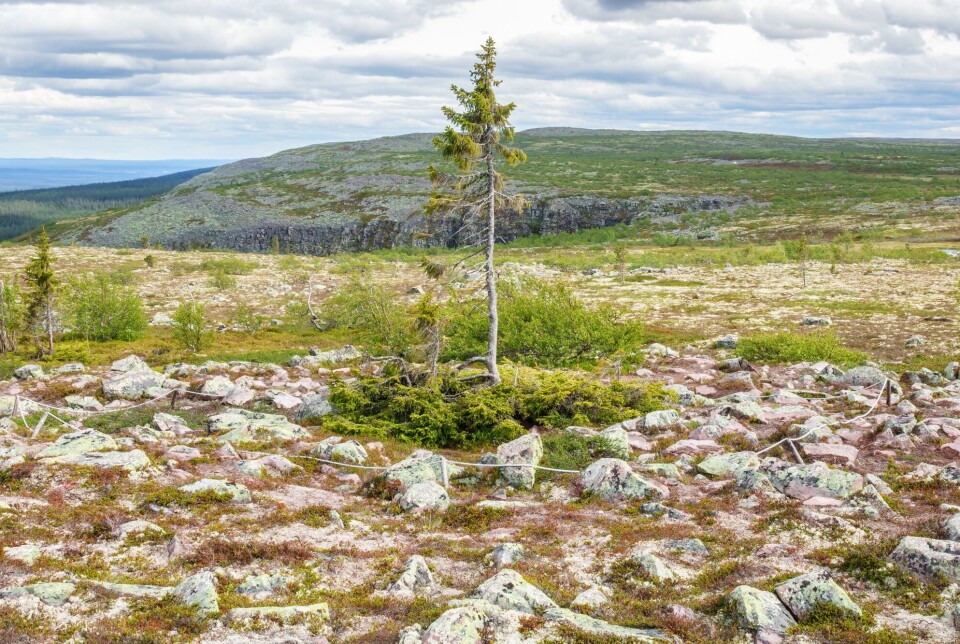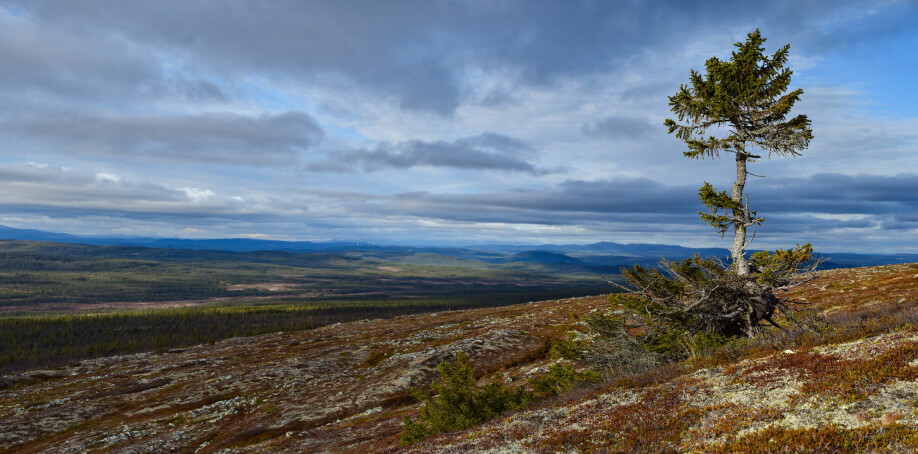
World's oldest tree still growing near the Norwegian-Swedish border
The nearly 10 000-year-old spruce tree is only five metres tall, but it began to grow just after the last ice age ended.
Not many years ago, Norwegian schoolchildren learned that spruce trees came to Norway from the east between 2 000 and 3 000 years ago.
But ten years ago, researchers at Umeå University in Sweden discovered a tree up on Fulufjället – in Sweden just east of Trysil municipality in Norway. The tree turned out to be 9 500 years old.
The researchers decided to name the tree after Tjikko, the dog that was with them on the trip when they found the spruce specimen. The tree was thus named Old Tjikko.
New DNA studies carried out by researchers at Uppsala University now show that the very first spruce trees may have come to southern Sweden as early as 14 700 years ago.
In other words, the spruce put down roots here just after the ice from the last ice age had started retreating.
Joined the land uplift after the ice age
“Our results indicate that the spruce followed the edge of the ice cover and wandered northward,” researcher Laura Parducci tells the Swedish journal Forskning & Framsteg.
The spruce trees have always stayed below the tree line of approximately 1 000 metres.
The reason why Old Tjikko now finds itself on the barren rock near Trysil – more than a hundred metres higher than what is considered the tree line – is simply that the spruce tree rose along with the mountain it grows on during the land uplift that followed the ice age.
Parducci and her colleagues published an article in the journal Nature Communication, reporting that they found the same genes in spruce trees growing below Fulufjället as Old Tjikko has.
“When Old Tjikko started to grow, it was at a significantly lower elevation than today. But once a spruce tree has taken root, it’s robust and can survive higher than the tree line. This is partly because spruces multiply through their root shoots,” says the Uppsala researcher.
Found several old trees
Ten years ago, researchers at Umeå University conducted four carbon-14 datings of wood remains they found around Old Tjikko. The results show the datings to be 375, 5 660, 9 000 and 9 550 years old.
All four samples were found to come from a single tree.
Today Old Tjikko’s tree trunk is only five metres high. Although the spruce may have had many such trunks over the millennia, the tree's root system has survived all these years. No part of today’s living tree is as old as 9 500 years, but genetically, the tree is exactly the same individual as when it began to germinate.
The researchers later found around 20 trees in mountain areas in northern Sweden and central Sweden, all of which are more than 8 000 years old.

Carbon-14 dating
Parducci and her colleagues conclude in their new study that the spruce tree probably entered Scandinavia from the east more than 14 000 years ago. Old Tjikko and Old Rasmus were part of this first wave of spruces that began to move west and north.
She explains to Forskning & Framsteg that the previous miscalculation of the spruce's shorter presence in Scandinavia came about due to a different aging method. This method estimated the age of the spruce's entry into the Nordic countries based on pollen found in bogs.
Now the researchers believe that their DNA studies will enable them to confirm that the spruce could have come to the Nordic countries already 14 700 years ago.
Where did the spruce tree come from?
Where the spruce came from when it established itself in Scandinavia after the ice age is still uncertain.
Could the spruce trees have simply survived the ice age in small ice-free pockets in the Nordic countries?
In a DNA study a few years ago, professor Inger Greve Alsos and her colleagues at UiT – The Arctic University of Norway found to their surprise that spruce trees might have actually survived the ice age in just such a pocket at the northern end of the island Andøya, in northern Nordland county.
They found 15 000 to 20 000-year-old DNA from pine and spruce trees at the bottom of a lake on Andøya, when the last ice age was at its coldest. The researchers have also found 10 300-year-old DNA from spruce in Nord-Trøndelag.
Parducci and her colleagues do not deny that Old Tsjikko’s ancestry might stem from Andøya. But they lean more towards the idea that the spruce trees that migrated to the Nordic countries when the ice age came to an end came from ice-free areas east or south of the large ice sheet that covered Scandinavia.
Translated by: Ingrid P. Nuse
References:
Kevin Nota et.al: Norway spruce postglacial recolonization of Fennoscandia. Nature Communications, 2022.
Mats Karlsson: Old Tjikko var en av urgranarna (Old Tjikko was one of the ancient spruces). Research & Progress, 2022.
The Research Council of Norway’s project bank: Ancient DNA of NW Europe reveals responses to climate change (Did trees grow on Andøya during the last ice age?).
———
Read the Norwegian version of this article at forskning.no
































